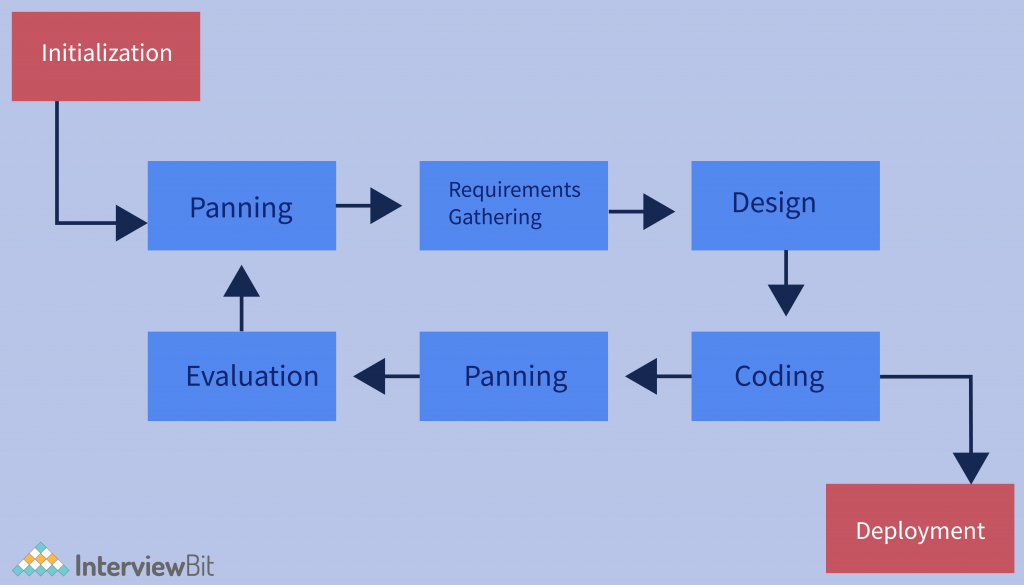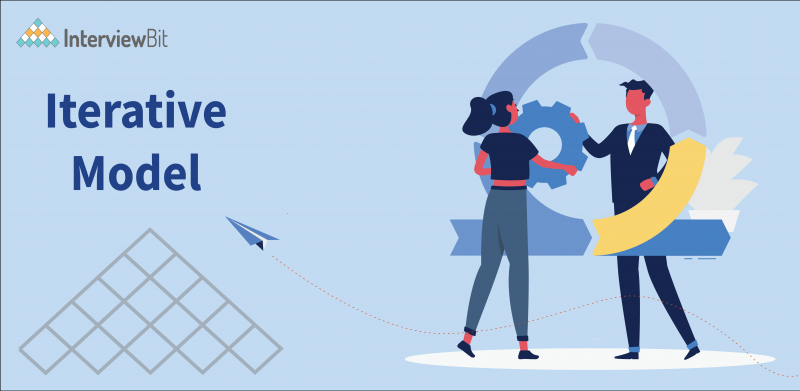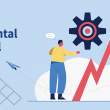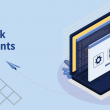Introduction
The iterative process model is a software development life cycle (SDLC) approach in which the initial development work is conducted based on initial requirements that are clearly defined, and subsequent features are added to this base software product through iterations until the final system is completed. This SDLC approach does not aim to create a comprehensive specification plan. Instead, the iterative development model is a method for breaking down any major software development project into smaller chunks. It is specifically designed to start with the bare minimum requirements and only construct a portion of the program iteratively. Post that, the prototype is examined again for any extra requirements and then the rest of the planning, requirement analysis, deployment, and maintenance are all conducted. This helps in identifying risks associated with the requirements at a early stage and mitigate them.
Features of the Iterative Model
Following are some features of the iterative model:
- It enables you to demonstrate and measure the progress of your project without any bias.
- The functionality of the project increases Incrementally.
- It lets you have a contant improvement in the quality of the project.
- With continuous improvements, it helps you lower down the chances of risk.
- You can experience good improvement in the accuracy of the various estimates that could be part of the project.
- It is also known as the cyclic model. After the initial phase, some phases occurs repeatedly and with the completion of each phase there is the scope of some improvement.
- Lastly, it helps increasing enthusiasm, collaboration, and effectiveness within the team.
Phases of the Iterative Model

1. Requirement and Planning Stage:
During this phase, the business requirements are collected, and an analyst determines whether or not they will be met within the allocated budget. It is used to layout the business needs in detail and the System information (hardware or software) is gathered and evaluated for feasibility.
Confused about your next job?
2. Design Stage:
In this phase, the project team gets the complete set of requirements to begin their work in a particular direction. They use different figures like a data flow diagram, class diagram, activity diagram, state transition diagram, etc to get a clear understanding of the software design and help them proceed with the development. Developers come up with many potential solutions based on their analysis. Additionally, the size and criticality of the project is also an important factor in determining the level and complexity of design for the project.
3. Coding Stage:
The actual construction of the system begins at this point in the project. This stage will be guided by the analysis and design resulted from the Design Stage. All of the requirements, planning, and design plans are executed and coded. The developer will implement the chosen design using predetermined coding and metrics standards. During the code development, they must implement a unit test at each level. This stage should aim to achieve the goal of developing fully functional, testable system for that iteration. Depending on the project, the complexity of efforts and time spent on this iteration will vary.
4. Testing Stage:
This step involves testing the current build iteration to a set of standards and norms to see if it meets them. Performance testing, stress testing, security testing, requirements testing, usability testing, multi-site testing, disaster recovery testing, and so on are all examples of this type of testing. A developer or a tester has to ensure that fixing one bug does not lead to emergence of additional bugs in the system. The tester can write new test cases or reuse ones from earlier builds, but testing is a top priority because any errors would affect the software’s specification thereby impacting the business. We can also check in with the project stakeholders to run some tests and inquire about any feedback they may have.
5. Evaluation Stage:
This is the last stage of the iterative model. After all the processes are complete, the system constructed up to this point is thoroughly evaluated. The system is examined by the development team, stakeholders, and other teams responsible for developing the project to see if the outcomes satisfy their expectations. A new requirement plan is produced and implemented as part of the next iteration cycle based on this.
Iterative Model Applications
Below are some of the scenarios where the iterative model is used actively:
- The iterative approach is used by many engineering teams to develop new features and apply problem-fixing techniques. The team may frequently produce new iterations that they believe are equally promising before testing them with users. They will make a list of pros and consand then work on the one that performed the best. This process is then carried out in a loop until the results are satisfactory.
- The world of electronics is following the iterative model. The development of mobile phones throughout the years, how speakers have gotten smaller and more portable over time, or even the way refrigerators from the same brands have changed to adapt to new family needs. All of these are iterative processes. The industry is reshaping itself every day based on customer feedback.
- The digital marketing teams test different advertising strategies to see which one gets better engagement. They understand the requirement of the advertisement, plan attractive designs by performing proper analysis and implement them in their product marketing. These copies are then shared with the members to get feedback and based on that the improvements are made. This improves their marketing strategies.
The use of an iterative model does not limit to one industry. Due to its features like parallel development, multiple testing, early risk identification, etc. It is adapted by various industries like Electronics, marketing, sales, etc, as discussed above.
Advantages
Before using the Iterative model in the Software Development Life Cycle(SDLC), it is critical to understand its benefits. The most significant benefit of this model is that it is adopted early in the software development process, allowing developers and testers to identify functional or design faults as early as possible, allowing them to take corrective action on a restricted budget and mitigate risks. Other advantages or benefits of this model include:
- In an iterative paradigm, less effort is spent documenting and more time is allocated to design.
- It is easily adjustable and flexible to the project’s and client’s changing requirements.
- In comparison to other process models, this paradigm is significantly less expensive to change requirements as we work on developing the project iteratively once the requirements are frozen.
- The end-user can swiftly provide input after each iteration, which can subsequently be incorporated into the system thereby improving the experience of the application.
- Early in the software development life cycle, some working functionality can be produced and released to the end users..
- It is possible to arrange parallel development since the iterations occurs simultaneously.
- Risks are recognized and resolved as early as possible thereby makingeach iterationreadily controllable.
- Since this model has smaller iterations,it makes testing and debugging simpler.
- When showing sketches and blueprints of a product to end users for feedback, it is possible to obtain trustworthy user feedback.
Disadvantages
Although the iterative paradigm is extremely beneficial, it does have some flaws and limitations. Furthermore, since every requirement is not collected at the start of the entire project’s life cycle, questions about system structure or outline may arise at later stages. Following are some of the disadvantages associated with the iterative model:
- Although the cost of change is lower, it is not well suited to constantly shifting needs.
- There is a need for proper management.
- If someone is looking to use this model for smaller projects then the iterative model is not the correct choice as it may not be possible or realistic to break down small projects into more smaller parts.
- This model requires highly skilled resources to work on the analysis part of the project to avoid risk.
- Since all the requirements are not gathered well in advance, problems with the system design may arise.
- The entire procedure is difficult to manage.
Conclusion
This brings you to the end of the blog. Now, you have got the brief understanding of the iterative model. The final product, which was created iteratively, meets the user’s requirements. This model allows you to spot any major design or planning issues in the process model and fix them as early as possible as this model iscyclic in nature. Furthermore, the iterative approach is quite useful since it can accept modifications in the system’s original requirements. This approach can also be used in conjunction with other models such as the incremental model, Agile methodology, and so on.
Coming up to the final thoughts, the selection of model depends upon the type of project you are working on. With each project, one model can overpower the other one based on several factors.
FAQs
Q: Where is iterative model used?
A: Some of the scenarios where iterative model is used is as follows:
- When all of the system’s requirements are fully specified and understood.
- The major requirements are stated, but as the development process progresses, some functionalities and suggested additions change.
- While working on the project, the development team is experimenting with and learning a new technology.
Q: Is waterfall model iterative?
A: Iterative model is similar to the waterfall concept, the only difference is that iterative waterfall allows you to go back to a previous phase and update the criteria, as well as make some changes if needed.
Q: What are the limitations of the iterative model?
Below mentioned are the important limitations of iterative model:
- For skill analysis, highly qualified personnel are required.
- For minor projects, this technique could be ineffective.
Additional Resources
- Practice Coding
- SDLC Vs STLC
- Waterfall Model in Software Engineering
- COCOMO Model in Software Engineering
- Incremental Model in Software Engineering
- RAD Model in Software Engineering
- Spiral Model in Software Engineering
- Software Engineering MCQ
- Software Engineering Books
- Software Engineering Resume
- Software Engineering Projects
- Characteristics of Software
- Principles of Software Engineering




